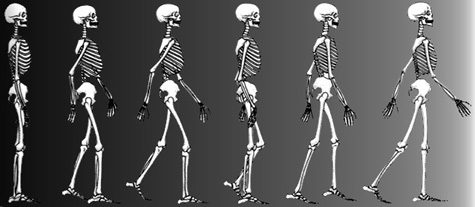
The Physical Characteristics of Humans
- Page 3 -
Erect Posture and Bi-Pedalism

One of the most distinctive human characteristics is our ability to walk erect (bipedalism). Living species of apes practice this form of locomotion occasionally, but rather awkwardly. A glance at the human skeleton, however, shows that human anatomy is expressly designed for it. The adaptation to erect walking has affected much of our skeletal structure. The skull balances on top of the spinal column, and the foramen magnum, the hole in the skull through which the spinal cord attaches to the brain, is centered at the bottom of the skull. Our skulls are designed to be carried erect. Humans have an S-curve in their spines to support the weight of the upper body flexibly. The pelvic structure has been adapted to carry the stress and weight associated with bipedalism, and the conjunction of our thigh bones with our hip sockets has also been modified for these purposes.
Fossil evidence shows that these changes in anatomy and the ability to walk upright actually precede the emergence of human (Homo) species.